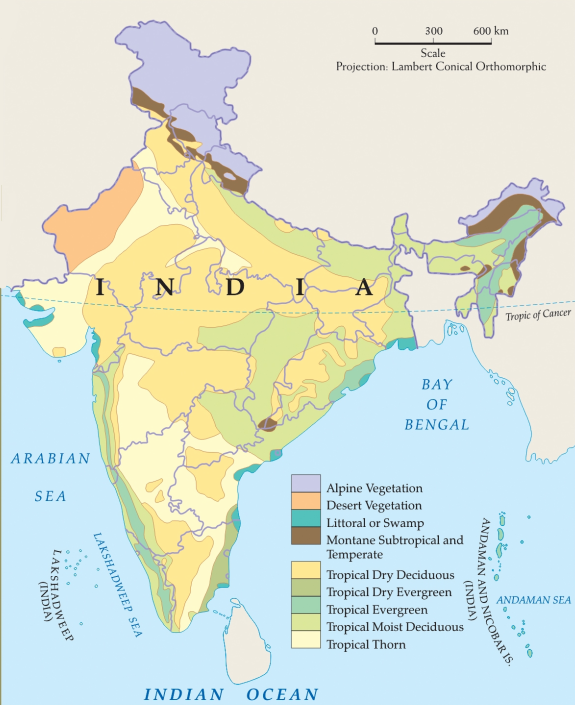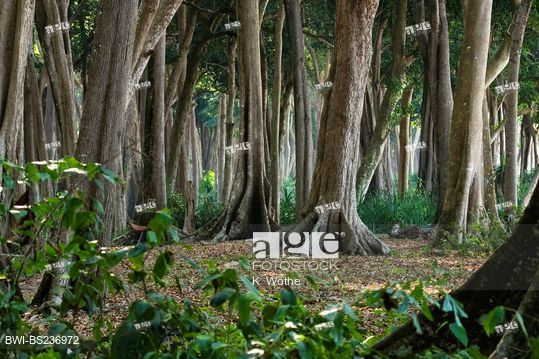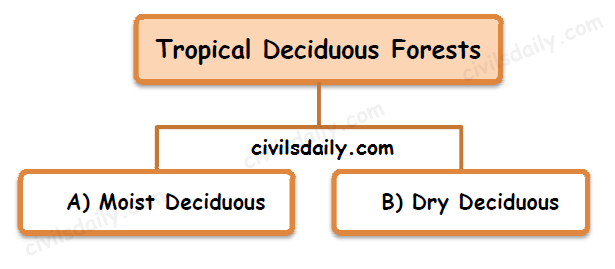Moving on, let’s discuss the various natural vegetation types of India in detail:
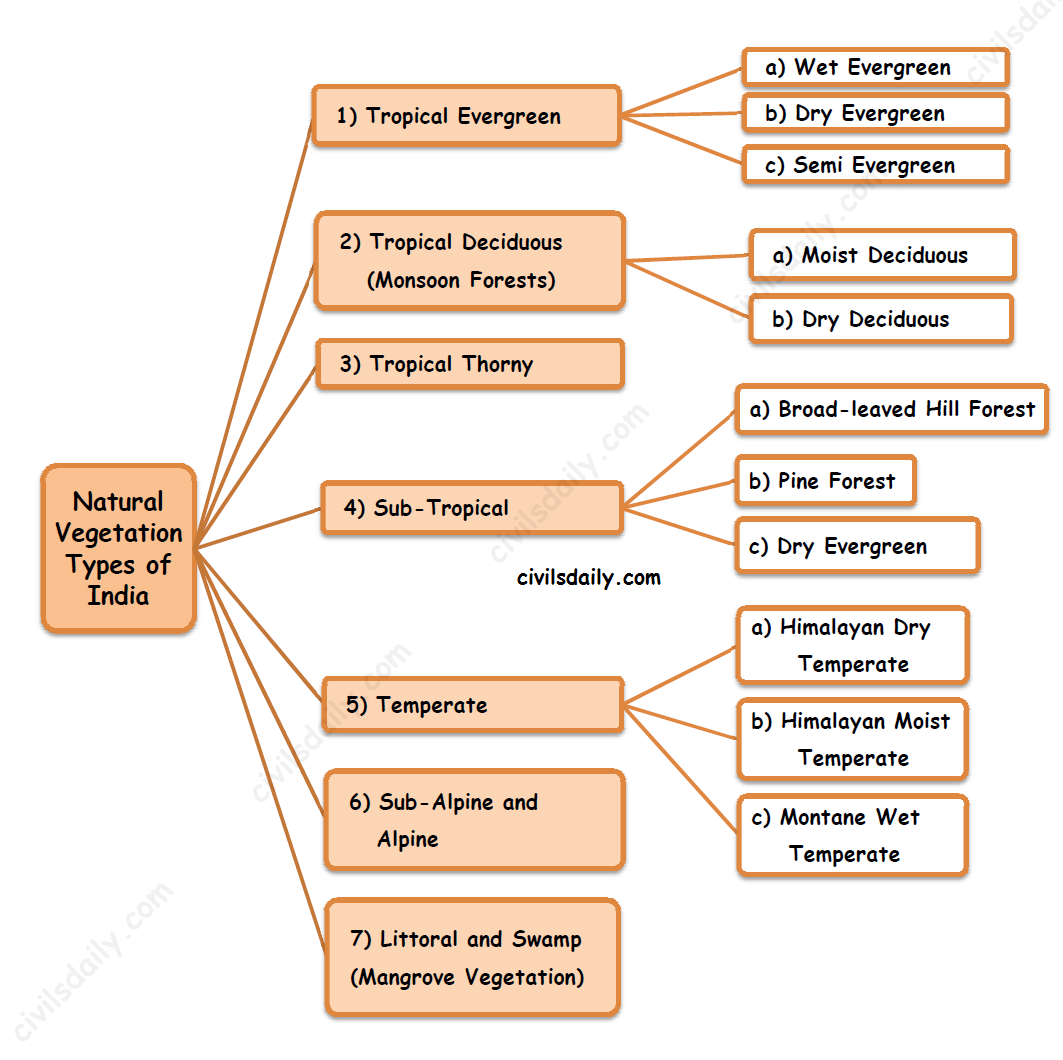
1. Tropical Evergreen Forests
‘Evergreen’ because there is no definite time for trees to shed their leaves, flowering and fruition. As such these forests appear green all the year round.
The common animals found in these forests are elephants, monkey, lemur and deer. The one-horned rhinoceros are found in the jungles of Assam and West Bengal. Besides these animals, plenty of birds, bats, sloth, scorpions and snails are also found in these jungles.
A. Tropical Wet Evergreen Vegetation:
- Distribution: These forests are found on the western slope of the Western Ghats, upper Assam through Cachar and the Andaman and Nicobar Islands.
- Climatic Conditions: They are found in warm and humid areas with an annual precipitation of over 250 cm and a short dry season. The mean annual temperature here is above 22°C.
- Characteristic Features:
- Tropical evergreen forests are well stratified, with layers closer to the ground covered with shrubs and creepers, followed by short structured trees, further followed by tall variety of trees.
- In these forests, trees reach great heights up to 60 m or above.
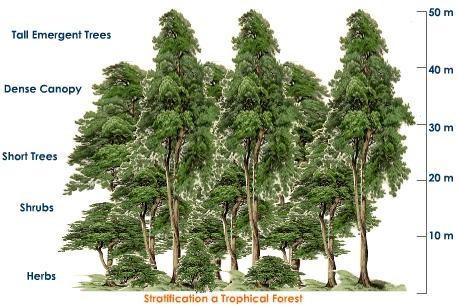
- Bounded by semi-evergreen forests on drier margins.
- Very rich biodiversity.
- Timber produced in these forests is fine-grained and durable.
- Important Species found in these forests: Rosewood, Mahogony, Aini, Ebony, etc. Important species in Kerala are Mesa, White cedar, Jamun, Canes etc. Common species found in Assam forests are Gurjan, Jamun, Agar, Bamboo etc.
B. Tropical Semi-Evergreen Vegetation:
- Distribution: These forests occur in areas adjoining tropical wet evergreen, and form a transition between evergreen and moist deciduous forests. These forests occur on the western coast, in Assam, on the lower slopes of the eastern Himalayas and in the Andamans in the areas where precipitation and atmospheric humidity is slightly less than that in tropical evergreen vegetation area.
- Characteristic Features:
- Such forests have a mixture of evergreen and moist deciduous trees. The undergrowing climbers provide an evergreen character to these forests.
- The climbers are heavy, bamboos are less prevalent and epiphytes are abundant. [Epiphytes – The plants which depend on other plants for mechanical support (and not for nutrients). e.g. lichens, mosses, orchids etc.]
- The forest is dominated by a variety of large trees with a tendency to gregariousness (i.e. growing in groups that are close together)
- Plant Adaptations in these areas:
- Buttresses – Many large trees have huge ridges called buttresses near the base that can rise 30 feet high before blending into the trunk. Buttress roots provide extra stability and increase the surface area of a tree so that it can ‘breathe in’ more carbon dioxide and ‘breathe out’ more oxygen. Typically, they are found in nutrient-poor rainforest soils and do not penetrate to deeper layers.
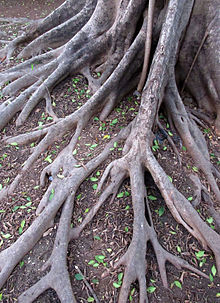
Source. A buttress root system provides structural support.
Big trees with buttress roots in tropical evergreen forest, India, Andaman Islands, Havelock Island. Source.
- The bark is thicker and rougher, and the canopy is less dense than that in the previous type. Also, the canopies are not continuous and species richness is lower
- Buttresses – Many large trees have huge ridges called buttresses near the base that can rise 30 feet high before blending into the trunk. Buttress roots provide extra stability and increase the surface area of a tree so that it can ‘breathe in’ more carbon dioxide and ‘breathe out’ more oxygen. Typically, they are found in nutrient-poor rainforest soils and do not penetrate to deeper layers.
- Main species are white cedar, hollock and kail. Important Species in Kerala are Aini, Laurel, Rosewood, thorny bamboo, etc. Important species of northeastern India are White Cedar, Indian Chestnut, Champa and Mango.
C. Tropical Dry Evergreen Vegetation:
- Distribution: This type is confined to the Tamil Nadu coast and the areas which receive rainfall of about 100cm mostly from the north-east monsoon/winter monsoon (October-December).
- The growth of evergreen forests in areas of such low rainfall arouses great botanical interest. This vegetation may be due to the seasonal distribution of rainfall (winter rainfall).
- Characteristic Features of this vegetation:
- Short height trees (<12m)
- A closed but low canopy of grasses and shrubs.
- No canopy layer differentiation.
- Bamboos are rare /absent.
- Important Species found in these forests: Neem, Jamun, Tamarind, Machkund, Khirni, Kokko, Ritha, Gamari Canes.
- Most of the land under these forests has been cleared for agriculture or casuarinas plantations (Eucalyptus tree plantations)
2. Tropical Deciduous Vegetation
Also called the monsoon forests, these are the most widespread forests in India. The term ‘Deciduous’ refers to the ability of some plants to lose their leaves annually. They are spread over regions which receive rainfall between 70 and 200 cm.
In these forests, the common animals found are lion, tiger, pig, deer and elephant. A huge variety of birds, lizards, snakes, and tortoises are also found here. [Currently, India is the only country on Earth confirmed to have both lions and tigers in its wilderness.]
On the basis of the availability of water, these forests are further divided into:
A. Tropical Moist Deciduous Vegetation
-
- Climatic Conditions: It thrives in areas having of moderate rainfall of 150-200 cm with a dry season of 4 to 6 months, a mean annual temperature of 26°C to 27°C and an average relative humidity of 60-80%. On the wetter margins, it has a transition to the tropical Semi-Evergreen Vegetation, while on the drier margins to the Tropical Dry Deciduous.
- Distribution: It is found on the eastern slopes of the Western Ghats, eastern coastal plains, eastern plateaus, Himalayan foothills and in some parts of the Satluj-Ganga plains.
- Characteristic Features:
- The trees shed their leaves during the dry season.
- These forests are usually 2 to 3 layered.
- Dense undergrowth
- Important Species: The common trees are Sal, Teak, Sandalwood, Ajun, Ebony, Shisham, Hurra, Mahua, Amla, Semul, Mulberry and Kusum.
B. Tropical Dry Deciduous Vegetation
- Climatic Conditions: The dry deciduous trees grow in areas where rainfall is less than 150cm and the dry period is relatively long. On the wetter margins, it has a transition to the moist deciduous, while on the drier margins to thorn forests.
- Distribution: It is found in Eastern Rajasthan, Kathiawar, rain-shadow areas of the Deccan plateau, central India and Punjab.
- Characteristic Features:
- These forests consist of trees less than 25m high, with a light canopy consisting of deciduous trees. The undergrowth is shrubby and grassy.
- As the hot dry season begins (March-May), the trees shed their leaves completely and the forest appears like a vast grassland with naked trees all around.
- In the higher rainfall regions of the Peninsular plateau and the northern Indian plain, these forests have a parkland landscape i.e. trees are more stunted and widely spaced and are interspersed with patches of grass.
- In the western and southern part of Rajasthan, vegetation cover is very scanty due to low rainfall and overgrazing.
- Important Species: Common plants are Teak, Sal, Laurel, Palas, Khair, Tendu, Amaltas, Bel, Axlewood etc.
3. Tropical Thorny Vegetation
- Climatic Conditions: In areas with 50-70cm of rainfall
- Distribution: It is found in south-western Punjab, western Haryana, western Uttar Pradesh, central and eastern Rajasthan, western Madhya Pradesh, Kachchhand, neighbouring parts of Saurashtra, leeward areas of Sahyadris.
- Characteristic Features:
- Plant life is highly specialized to adapt to the coarse and dry conditions in this area, with long roots, small leaves, stems that store water, and prickly spines that discourage animals from touching or eating them.
- The natural vegetation consists of open stunted (trees with 6-9m height) forest breaking down into xerophytic bush and western Rajasthan grading into deserts.
- In these forests, plants remain leafless for the most part of the year and give an expression of scrub vegetation.
- Plant adaptations:
- These xerophytic plants combat drought with certain devices of water preservation like partial or complete replacement of leaves by thorns, waxy leaves, water storing cells, hair on the stalk etc.
- Tussocky grass grows up to a height of 2 m as the undergrowth.
- Trees are scattered and have long roots penetrating deep into the soil in order to get moisture.
- The stems are succulent to conserve water.
- Leaves are mostly thick and small to minimize evaporation.
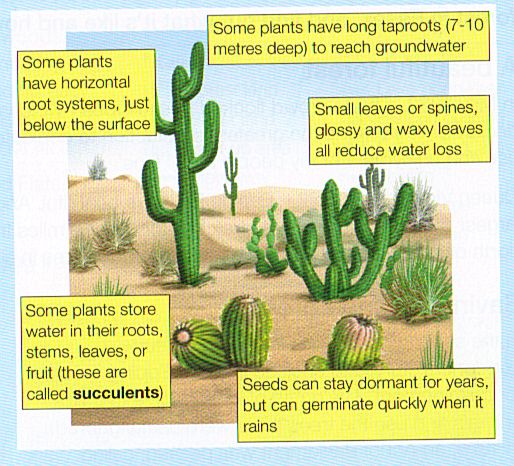
Source
- Important Species: Common species are Babul, Acacia, Kokko, Khair, Khajuri, Ber, Neem, Khejri, Palas, etc.
- In these forests, the common animals are rats, mice, rabbits, fox, wolf, tiger, lion, wild ass, horses and camels.
